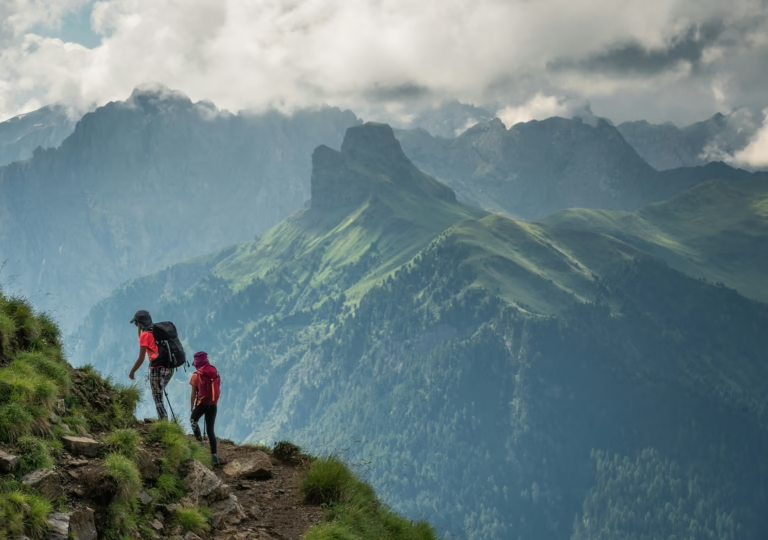Every year, snakes bite a huge 5.4 million people across the globe, says the World Health Organization. Out of those, almost 2 million folks get venom injections. Sounds scary, right? But don’t let that ruin your fun in the great outdoors.
Think of it this way: with a little knowledge and preparation, you can minimize the risk and maximize the fun on your next trail adventure.
That’s why I’m sharing my trail-tested wisdom, from researching local snakes to packing the right gear (yes, even a snakebite kit, just in case!).
We’ll cover everything you need to know: identifying common hiking snakes, what to do if you see one, and most importantly, how to avoid them altogether.
With these handy snake safety tips in your pocket, you’ll be ready to conquer any trail with confidence (and maybe even a little swagger). Let’s roll!
How to Stay Safe from Snakes while Hiking?
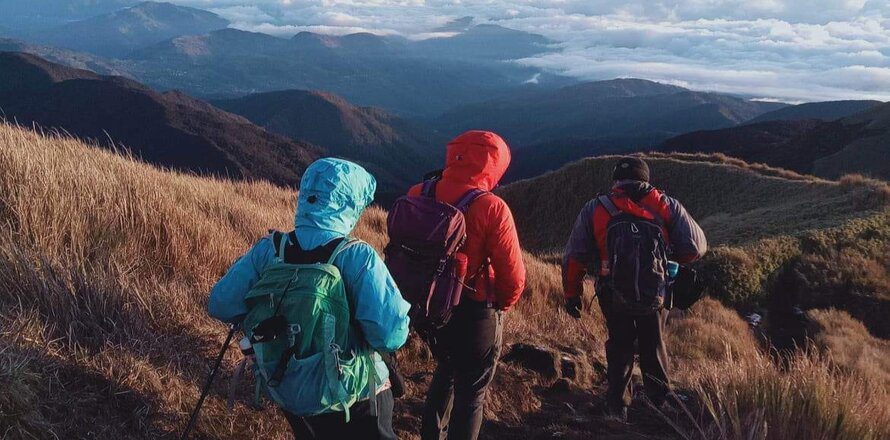
To stay safe from snakes while hiking, stick to well-trodden paths, avoid tall grass and rocky outcrops, wear sturdy boots and long pants, and be cautious when stepping over rocks or logs.
Stay alert, make noise, and, if encountered, give snakes a wide berth to prevent accidental bites. Now, for the longer version!
I’ve been on enough trails to know that encountering a snake can send shivers down even the most seasoned hiker’s spine.
But here’s the thing: with a little preparation and knowledge, those shivers can turn into confident strides. Let me share the tricks I’ve learned to maintain peace with trail snakes.
Know Your Enemy (And They’re Not Really Enemies)
Before you even think about lacing up, do a quick Google search. Identify the common snake species in your hiking area, especially any venomous ones. Understanding their appearance and behavior is your first line of defense.
Bonus points: chat with park rangers or experienced hikers for local intel on snake activity. I once learned about a rarely-seen rattler hotspot thanks to a friendly ranger – knowledge is power!
Gear Up for Peace of Mind
Forget sandals and shorts! Sturdy beginner’s hiking boots and long pants are your most reliable hiking snake protection.
Opt for thicker materials like denim or canvas and consider gaiters for ankle coverage, especially in tall grass areas. They saved me from a close call with a cottonmouth once – trust me, they’re worth it!
Plan Your Hike Like a Pro
Sticking to well-maintained trails is like having a built-in snake-avoidance system. Plus, you’re less likely to surprise a snake (and vice versa!). Aim for hikes during the middle of the day when snakes are less active.
Bonus Tip: Let someone know your hiking plans and estimated return time. It’s a simple step that could make a big difference in an emergency. My hiking buddy and I always do this – it’s like an unwritten safety rule.
What to Do When You See a Snake While Hiking?
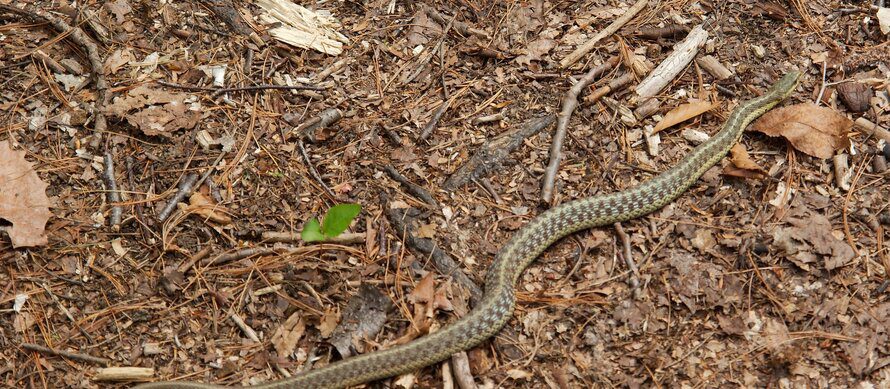
If you encounter a snake while hiking, remain calm, avoid sudden movements, and slowly back away. Give it plenty of space, and do not provoke or attempt to handle it. Allow the snake to move away on its own.
In most cases, the snake will be on its way, and you’ll be able to get back to your hike without getting bitten.
What Scares a Snake Away?
Snakes are typically scared away by vibrations and loud noises, so if you can make your presence known on time, they will hide from your path before you even get the chance to see them.
Here are some reliable methods backed by research and my own trail experience:
- Be the loud one: Tapping your trekking poles firmly on the ground, shuffling your feet, or even clapping your hands creates vibrations that alert snakes to your presence and encourage them to retreat.
- Don’t forget the scents: While snakes don’t have the best noses, certain strong odors can be unpleasant and deter them. Consider carrying a small container of mothballs (in a sealed bag for safety) or commercially available snake-repellent sprays. However, remember that these should only be used as a last resort and never directly sprayed on a snake.
- Stand tall (figuratively, of course): Making yourself appear larger can sometimes deter curious snakes. Slowly raise your trekking poles or even your backpack above your head to increase your perceived size. This can be particularly helpful if you encounter a smaller, non-venomous snake that might be feeling defensive. [1]
- Water is your friend: Snakes generally avoid open water, so if you’re near a stream or lake, creating a barrier between you and the snake can be a good option. However, never attempt to corner or force a snake into the water, as this can make it more defensive.
Bonus Tip: While some recommend using ammonia or other harsh chemicals, I strongly advise against it. These substances can be harmful to both humans and the environment, and their effectiveness against snakes is often unreliable. Plus, they can irritate snakes and make them more likely to bite.
How to Recognize a Snake Bite?
You can recognize a snake bite by quickly inspecting the area and looking for two puncture wounds. They usually appear on limbs or feet. However, other signs usually come with a snake bite. Here are the main symptoms I am looking for when I suspect one:
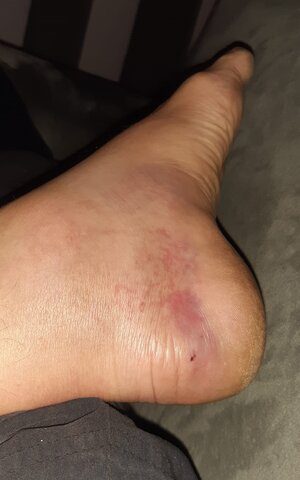
- Pain and swelling: The bitten area will likely swell and throb with pain. The intensity can vary depending on the snake species and the amount of venom injected, but some pain is almost always present.
- Redness and bruising: Redness and discoloration around the bite are common symptoms. In some cases, there might also be bruising or even blistering.
- Other warning signs: Depending on the type of venom, you might experience additional symptoms like nausea, vomiting, dizziness, difficulty breathing, or even paralysis. These require immediate medical attention.
What to Do If a Snake Bites You?
If a snake bites you, dial emergency services immediately and inform them it’s a snake bite. The sooner you receive professional medical attention, the better. Then, according to the emergency class for hiking snake protection I’ve taken last year, you follow the next steps:

- Immobilize the bitten area: This helps slow the spread of venom. If possible, splint the limb using something sturdy like a trekking pole or branches (without restricting blood flow). If the bite is on your torso, keep it still.
- Remove restrictive clothing or jewelry: Swelling will likely occur, so loosen tight clothing or jewelry around the bite to avoid further discomfort and potential complications.
- Monitor your symptoms: While waiting for help, keep an eye on your condition. Note any changes in pain, swelling, breathing, vision, or other symptoms. This information will be crucial for medical professionals.
Bonus Tip: Consider carrying a small, whistle-based emergency beacon. It can attract attention and signal for help, especially in remote areas.
What Not to Do if a Snake Bites You?
If a snake bites you, you should forget everything you’ve seen in the movies.
Let’s dispel some dangerous myths and highlight what to avoid:

- Myth – The Hollywood Treatment: Forget sucking out the venom (it’s ineffective and potentially risky), applying ice packs (it can restrict blood flow and worsen tissue damage), or using tourniquets (they can cause serious complications). These methods are outdated and potentially harmful. Stick to professional medical attention! [2]
- Myth – Drink alcohol or caffeine: Alcohol thins your blood and can interfere with antivenom, so resist the urge to numb the pain with a drink. Stay hydrated with water instead.
- Myth – Cut the bite and let the blood flow out. While some outdated advice suggests cutting around the bite to “release” venom, this can lead to excessive bleeding and infection. Leave any medical procedures to the professionals.
- Myth – Identifying the snake is crucial: Identifying the snake might seem important but focus on getting help first. The medical professionals will handle that part. Remember, every bite requires immediate medical attention, regardless of the snake.
- Myth – Run around to “pump out” the venom: This increases your heart rate and venom circulation – the opposite of what you want!
Bonus Tip: Consider taking a wilderness first aid course specifically designed for snake bites. And bring a snake kit with you. It can bring a little relief before your saviors arrive.
Types Of Snakes You May Encounter While Hiking
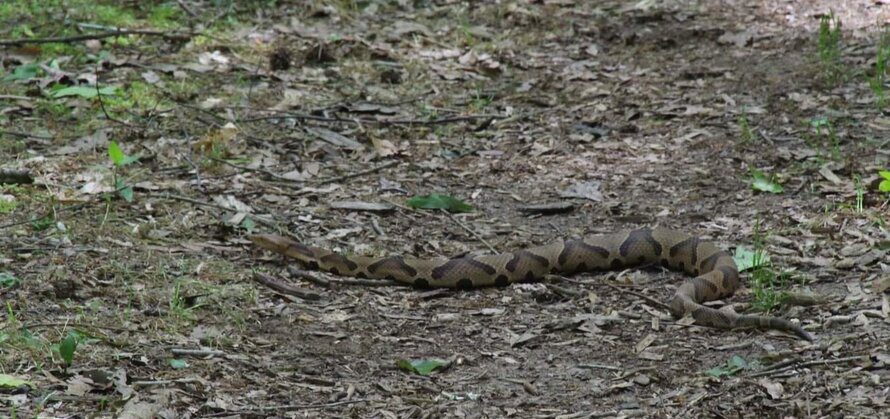
Here’s a quick guide to some common ones you might meet on your hikes, along with some tips that helped me stay cool and collected:
United States
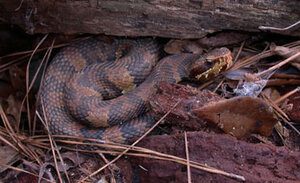
- Rattlers: These guys come with built-in warning systems – those signature rattles. Found across most of the US, they can vary in color and pattern. But not all rattlers announce themselves before a strike, so keep your eyes peeled!
- Copperheads: These shy snakes prefer rocky areas and woodlands in the eastern and central US. Look for their copper-toned bodies with hourglass markings on their backs. They’re most active at dusk and dawn, so be extra cautious.
- Cottonmouths: Found near water in the southeast US, cottonmouths have thick bodies, olive-brown coloration, and characteristic wide heads with white bands. Their name refers to their bluffing tactic of gaping their mouths wide, not to literal cottonmouths! Speaking of bluffing, I once saw a cottonmouth do its thing, and let me tell you, staying calm and remembering that information helped me avoid a needless freak-out.
- Garter snakes: These slender, harmless snakes are common across the US and come in a variety of colors and patterns. They often have stripes or spots running down their backs and tend to be more active during the day.
- Kingsnakes: These non-venomous constrictors are excellent rodent hunters, making them frequent visitors to barns and farms. They come in various colors, but many have yellow bands around their black bodies. I used to mistake kingsnakes for coral snakes, which are venomous until I learned to recognize the key difference: the colored bands on kingsnakes touch the belly, while coral snakes, only touch the black rings.
Europe
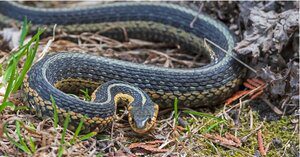
- Adder (Vipera berus): Found across much of Europe and parts of Asia, this is the continent’s only widespread venomous snake. It’s typically grey or brown with a zigzag pattern and prefers cool, damp areas. Their bites are rarely fatal, but seeking medical attention is crucial.
- Grass snake (Natrix natrix): This widespread, non-venomous snake is Europe’s most common. Look for its green or brown body with yellow markings down the back. They’re excellent swimmers and often found near water.
- Smooth snake (Coronella austriaca): Another non-venomous friend, the smooth snake favors rocky areas and woodlands in central and southern Europe. Its smooth, grey or brown scales and shy nature make it easy to miss. But if you spot it, bask in its harmless beauty!
- Dice snake (Natrix tessellata): Found near water in southern Europe, this non-venomous snake has a distinctive, checkered pattern on its back, earning it its name. They can sometimes be mistaken for vipers, but remember, vipers have triangular heads and vertical pupils, while dice snakes have round heads and round pupils.
- Hornsnout viper (Macrovipera schweizeri): Found only in a small region of the Swiss Alps, this viper is quite rare and strictly venomous. It has a unique, upturned snout and prefers rocky alpine meadows. Thankfully, encounters are very unlikely for most hikers.
Frequently Asked Questions
To identify a venomous snake, look for triangular-shaped heads, vertical pupils, and heat-sensing pits on their faces.
Many venomous snakes have vibrant colors, but some non-venomous species mimic these patterns. It’s safest to treat all snakes with caution and avoid close contact.
The best time to minimize snake encounters while hiking is during the cooler parts of the day – early morning or late afternoon. Snakes are more active in warm temperatures. Stick to well-trodden paths, avoid tall grass, and be cautious when stepping over rocks or logs.
If bitten by a rattlesnake in the backcountry, seek immediate medical help. Keep the bitten limb immobilized, below heart level, and avoid using a tourniquet or applying ice. Do not try to suck out the venom. Call for emergency assistance and stay as calm as possible.
References:
- https://www.quora.com/Should-one-make-himself-look-bigger-or-smaller-when-encountering-a-venomous-snake
- https://www.nytimes.com/2004/07/12/health/the-claim-you-can-treat-a-snakebite-by-sucking-out-the-venom.html


